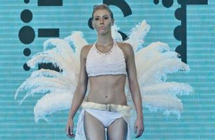牛粪时装:荷兰设计师将牛粪改造成时装
|
很多人身上的化纤衣服都是石油做成的,那么牛粪做成的衣服你穿过吗?你的第一反应可能是这种衣服会不会臭不可闻。放心,就像化纤衣服上闻不到石油的味道,牛粪时装也不会保留那种臭烘烘的原始味道。一起来了解一下吧! With cattle breeding at an all time high, manure has become one of the world’s greatest environmental hazards, but one Dutch artist is using chemistry to turn into something that is both eco-friendly and valuable. Her innovative technique turns manure into a variety of useful materials like clothing fabric, bio-degradable plastic and paper.
In recent years, scientists around the world have made great progress in their attempts to recycle cattle manure, including turning it into natural fertilizer and biogas, but Eindhoven designer Jalila Essaïdi didn’t think they were efficient enough to solve the global manure surplus problem. So she started on her very own solution, one that approached animal waste as a valuable material that could be processed into useful products. The results of her work prove that manure really is worth its weight in gold. Working in her BioArtLab, Jalila Essaïdi discovered that cow manure provided both the base for a new, bio-degradable material and the chemicals required to produce it. She started by separating the waste, with the dry manure used to extract pure cellulose from the grass that cows eat. From the wet manure, she extracted acids used to create cellulose acetate, a natural liquid plastic. This was used to make fibers, which are later turned into fabric or bio-plastics, but it can also be freeze-dried to create an aerogel. The new material was named Mestic, from mest, the Dutch word for manure. Essaïdi claims that it has the same properties as plastic derived from fossil fuels, but is bio-degradable. Better yet, the degradability can be tweaked in the lab, making it possible to create materials that last for different periods of time depending on their purpose. “This is not the first time that scientists are looking for ways to solve the manure problem, but it is the first time that manure is being considered as a valuable resource,” the Dutch designer said. Last year, Jalila Essaïdi partnered with the municipality of Eindhoven to produce a fashion show using Mestic-based fabrics. Her Mestic couture collection was so impressive that clothing giant H&M awarded her the Global Change Award and a $1 million prize. And just in case you’re wondering, no, manure-derived clothes don’t stink. Essaïdi now plans to increase Mestic production and work on making it usable in 3D printing, but that requires a bit more research to tweak its melting temperature. She also intends to use the material to build a bridge in her home city of Eindhoven to further showcase the versatility of this innovative invention. And cow manure is just the beginning of Jalila Essaïdi’s experiments with animal waste. “After cows, we’ll tackle pigs and other animals,” she told Dezeen. “And after that? Who knows.” |









